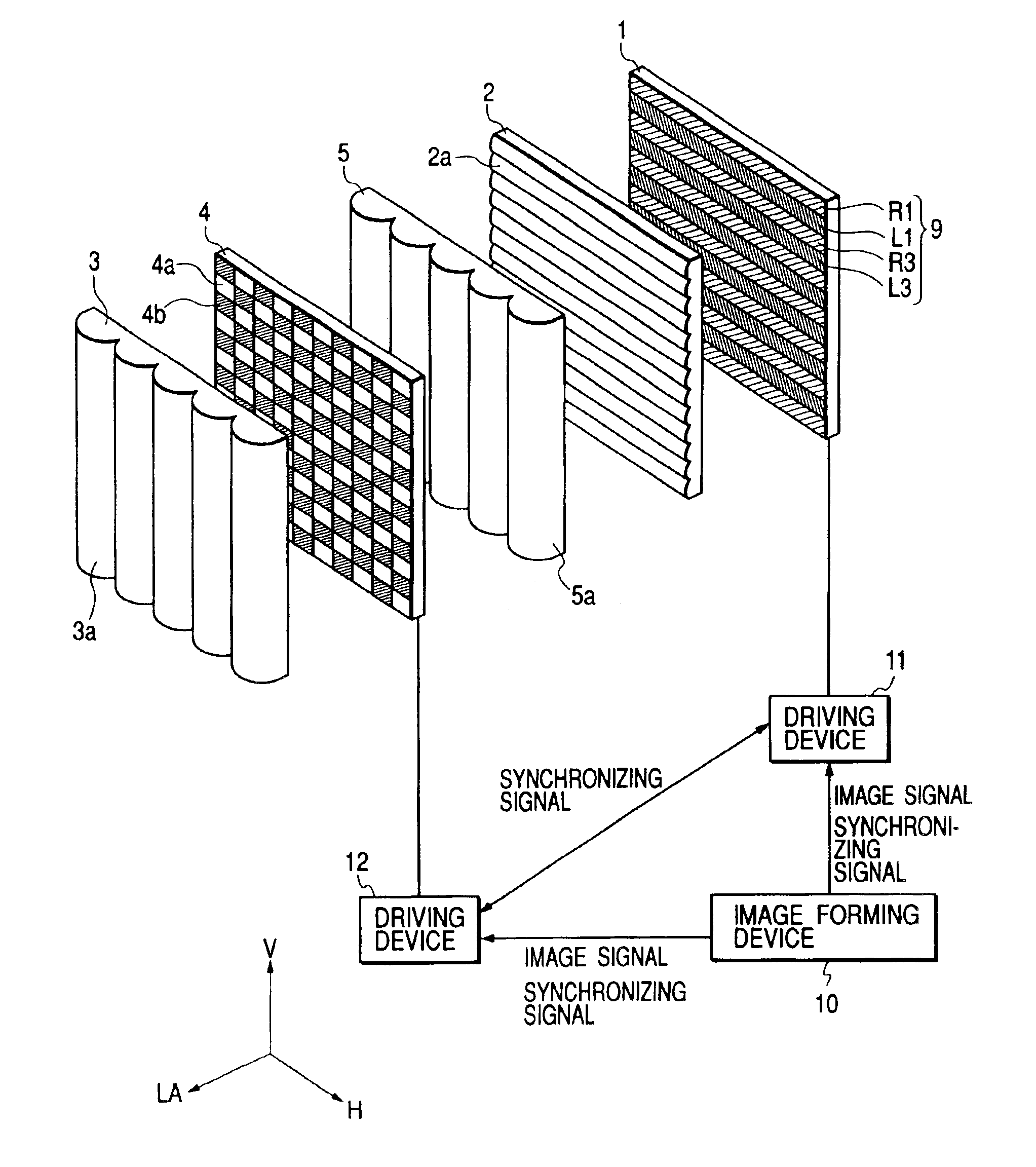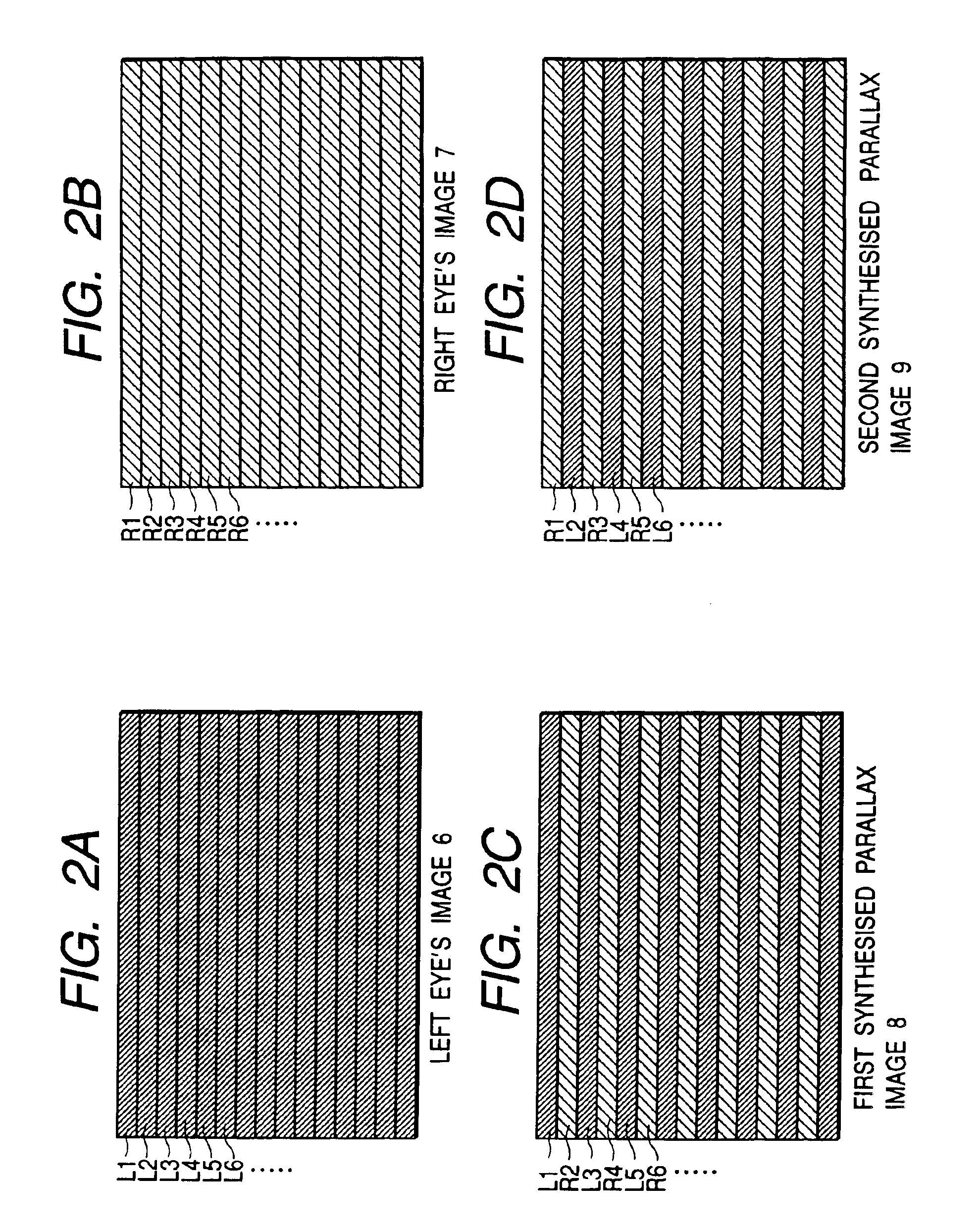Method and apparatus for stereoscopic image display
a stereoscopic image and apparatus technology, applied in the field of stereoscopic image display, can solve the problems of reducing resolution and halving the number of display pixels, and achieve the effects of reducing cross talk and moiré, high resolution and high resolution
- Summary
- Abstract
- Description
- Claims
- Application Information
AI Technical Summary
Benefits of technology
Problems solved by technology
Method used
Image
Examples
first embodiment
(First Embodiment)
[0062]FIG. 1 is a main part perspective view illustrating an image displaying state at a certain instance in a first embodiment of the present invention. Two pieces (a plurality) of synthesized parallax images that are synthesized from parallax images of two viewpoints (or two or more viewpoints) to be described later are alternately displayed on an image displaying device 1. Reference numeral 2 denotes a horizontal lenticular lens, which has a plurality of cylindrical lenses (optical elements) 2a having a refraction power in the vertical direction V. Reference numeral 3 denotes a first vertical lenticular lens (first optical system), reference numeral 4 denotes an optical modulator that is capable of controlling a light shielding section and a light transmitting section with respect to predetermined polarized light, and reference numeral 5 denotes a vertical lenticular lens (second optical system). The first and the second vertical lenticular lenses 3 and 5 have a...
second embodiment
(Second Embodiment)
[0103]FIG. 12 illustrates a second embodiment of the present invention, in which identical reference numerals are given to the members identical with those in the figures already referred to. This embodiment is different from the first embodiment in that the optical modulator 4 has a first phase shift member 41 that gives transmitted light two different phase shift states by an electric signal and a polarizing optical device 42. Here, this point will be described in detail.
[0104]The image displaying device 1 is configured such that light to be emitted will be linearly polarized light having a polarized face oscillating into a paper surface of the drawing. This can be realized by setting a polarization plate used in an LCD in a predetermined direction if the LCD is used in the image displaying device 1, and can be realized by disposing a polarization plate in the front of a displaying surface of an automatic light emission type displaying device such as a CRT and a...
third embodiment
(Third Embodiment)
[0122]FIG. 20 illustrates a third embodiment of the present invention, in which identical reference numerals are given to the members identical with those of the figures already referred to. This embodiment is different from the second embodiment in that the first phase shift member (π cell) 41 is arranged immediately in front of the image displaying device 1 and, particularly, that it is arranged separately from the polarizer 42 (the second shift member 421 and the polarization plate 422) described with reference to FIGS. 12 to 19.
[0123]In this embodiment, each component is also arranged such that the relations (h1) to (h11) and (v1) to (v3) of the design parameters already described are satisfied. However, the polarizer 42 (or the second phase member 421 and the polarization plate 422) is arranged instead of the optical modulator 4 of the first embodiment, and an interval (optical distance) between each member is determined taking into account an optical thicknes...
PUM
 Login to View More
Login to View More Abstract
Description
Claims
Application Information
 Login to View More
Login to View More - R&D
- Intellectual Property
- Life Sciences
- Materials
- Tech Scout
- Unparalleled Data Quality
- Higher Quality Content
- 60% Fewer Hallucinations
Browse by: Latest US Patents, China's latest patents, Technical Efficacy Thesaurus, Application Domain, Technology Topic, Popular Technical Reports.
© 2025 PatSnap. All rights reserved.Legal|Privacy policy|Modern Slavery Act Transparency Statement|Sitemap|About US| Contact US: help@patsnap.com



